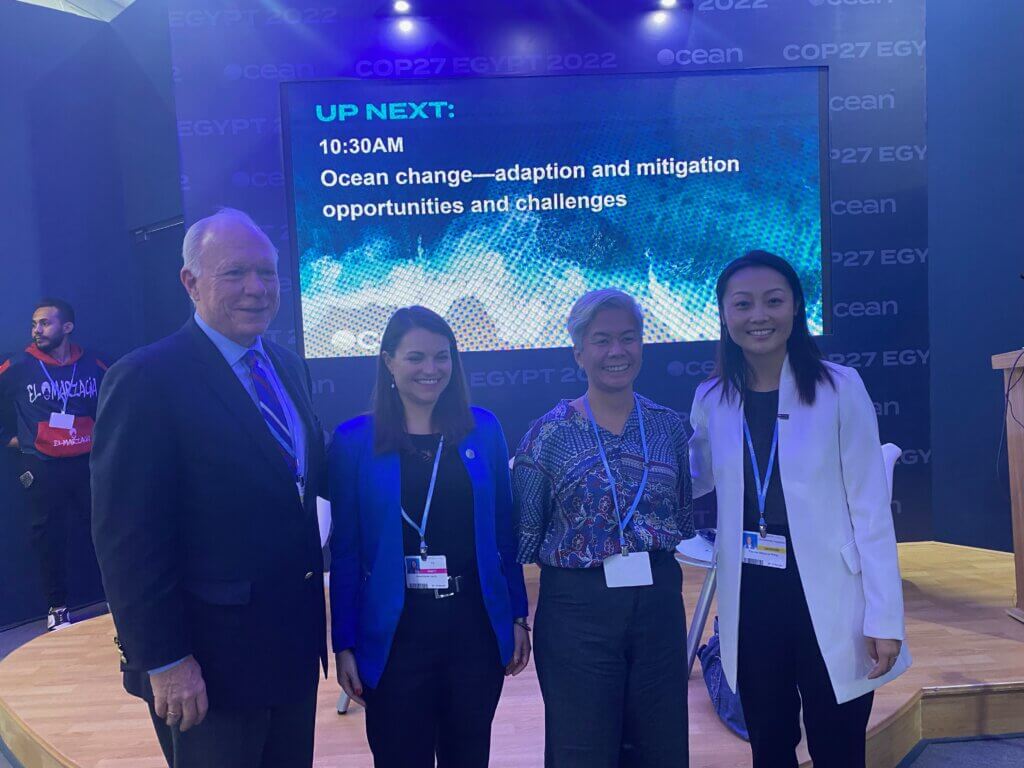By Tony MacDonald, Monmouth University Urban Coast Institute Director

The ocean community has come a long way from the 2015 United Nations (UN) Climate Change Conference in Paris (COP21), when we were fighting to get the important role of oceans in climate called out in the preamble of the conference declaration, and ocean events organized by the late Dr. Biliana Cicin-Sain and others were relegated to a venue outside of the diplomatic zone. In November at COP27 in Egypt, the Woods Hole Oceanographic Institution and Scripps Institution of Oceanography joined with other oceanographic partners and policy and science leaders from around the globe at the first-ever Ocean Pavilion in the so-called Blue Zone, where diplomatic representatives and official observer groups meet.
The Urban Coast Institute (UCI) secured official observer status at COP26 in 2021. When I arrived on site on Nov. 11, I was pleased to find the Ocean Pavilion right around the corner from the U.S. Pavilion, where President Biden’s in-person address to the conference was being streamed live.
To open the conference, UN Secretary General Antonio Guterres, reflecting the increasingly dire predictions of the latest scientific reports (i.e. the IPCC Sixth Assessment Report) and urgent calls for more aggressive action to reduce carbon emissions in order the meet the COP21 agreement’s target of limiting a global temperature increase to 1.5 degrees Celsius, set an ominous tone, declaring, “We are on a highway to climate hell with our foot still on the accelerator.” Two weeks later when the parties adopted their final declaration, the Sharm el-Sheikh Implementation Plan, most commenters felt that despite progress in a few areas they had fallen well short of meeting this.
The main areas of focus were the mitigation of greenhouse gas emissions (GHG) to keep with the 1.5-degree target; support for adaptation for impacts that are already “baked” into the climate; and simplifying and clarifying access to international finance mechanisms, and the establishment of something called a “loss and damage” fund. It was hard for delegates not to look over their shoulder to the war in Ukraine, political instability at home, and volatile energy prices as they entered into negotiation.
Although in the end it was agreed to maintain the Paris agreement’s 1.5 C target through “rapid, deep and sustained reductions in global GHG emissions” and rapid transition to renewable energy, that ignores the reality that the aggregated effect of parties’ implementation plans and mitigation pledges through what are called National Determined Contributions (NDC) currently fall far short of what is needed. They rejected calls from many nations for the phase-out of subsidies and phase-down of all fossil fuels. The final decision defaulted to the somewhat mealy-mouthed commitment to the phase-down of “unabated coal power” and the phase-out of “inefficient fossil fuel subsidies … in line with national circumstances.” It wouldn’t take much of a lawyer to drive a carbon-spewing truck through these requirements.
It is important to recognize, however, that it isn’t necessary to have binding international agreements to drive action at the state and local levels, where there is a growing consensus that more aggressive carbon reduction actions are necessary. I participated in two panels at COP27 which featured innovative actions to reduce carbon and contribute to more aggressive NDCs. Sen. Sheldon Whitehouse (Rhode Island) provided opening remarks for the first session at the Ocean Pavilion (see video above). The session highlighted policy innovations at the ocean-climate nexus to accelerate decarbonization and improve the blue economy, including green shipping, local fisheries practices and aquaculture in the Philippines, and ocean-based renewable energy. (Click here to view additional videos of Ocean Pavilion presentations.)

The second panel, “Coordination and Collaboration towards Ocean Blue NDCs,” was hosted by the Global Ocean Forum, the Government of Fiji and several other international partners. The panel was kicked off by the ambassador and permanent representative of Fiji to the UN in New York and featured collaborative initiatives among various stakeholders from Africa, France, Canada and the U.S. which support the incorporation of ocean action to strengthen the NDCs. In each panel I highlighted work that the UCI and others are doing in the Mid-Atlantic to collaborate with state and federal government partners, stakeholders and scientists to support regional ocean planning, including responsible siting of offshore wind, sustainable marine navigation, as well as support for healthy ocean ecosystems.
In addition to the on-site Ocean Pavilion, the Global Ocean Forum organized the Virtual Ocean Pavilion to amplify what was happening at COP27 and bring voices to the table from around the world to showcase why the ocean matters in climate negotiations and to all life on our planet. All of that information is still available.
Although the final declaration restates the need for adaptation support for finance, technology transfer, and capacity-building for developing nations, it rejected demands for developing nations to double adaptation finance by 2025. Some progress was made in recognizing the importance of reforming international finance mechanisms, setting up a pathway for future negotiations, including the need to provide $100 billion per year to developing countries for the implementation of mitigation and adaptation ambitions. Several late nights and last-minute negotiations were needed to reach a breakthrough after many years of contentious negotiations to establish a “Loss and Damage” fund to support communities that have been most affected by climate change. However, in order to reach consensus, the hard work of how much, how to administer, and how to access finance through the fund was left to future negotiations.
In addition to being called out in the preamble of the final COP declaration (“the importance of ensuring the integrity of all ecosystems, including in forests, the ocean and the cryosphere, and the protection of biodiversity”), the importance of the oceans was noted in several other provisions, including the following:
- The “importance of protecting, conserving and restoring nature and ecosystems … including through … marine ecosystems acting as sinks and reservoirs of greenhouse gases and by protecting biodiversity.”
- Expanded commitment to UN-hosted “ocean and climate change dialogues.”
- Encouraging parties to include “ocean-based action in their national climate goals.”
- The need to fill “systematic observation gaps … for ocean, mountain, desert and polar regions and the cryosphere in order to improve understanding of climate change.”
In addition to serving as the venue for the diplomatic meetings and negotiation highlighted here, the COP functions as a hybrid trade show, uber-networking event, and platform for initiating and announcing other related actions and partnerships. The U.S. reiterated its commitment to climate-ocean solutions and the High Level Panel for a Sustainable Ocean Economy, joined Norway and other nations in launching the “Green Shipping Challenge,” and joined the Global Offshore Wind Alliance (GOWA). France expressed its support for the prohibition of seabed exploitation.
Although some progress was made in bringing the oceans into the climate negotiations, there is still a lot of work that needs to be done to take a comprehensive and holistic approach to ocean conservation and sustainable use, including biodiversity, seabed mining, plastics, and governance of the high seas beyond national jurisdictions. For example, over the past two weeks, the US has been meeting with other nations in Montreal for the UN Convention on Biological Diversity (CBD) and negotiations of a post-2020 global framework for biodiversity. It remains to be seen whether the CBD will take actions necessary to maintain and restore the health of our global ocean, and ensure it continues to regulate the climate system.

